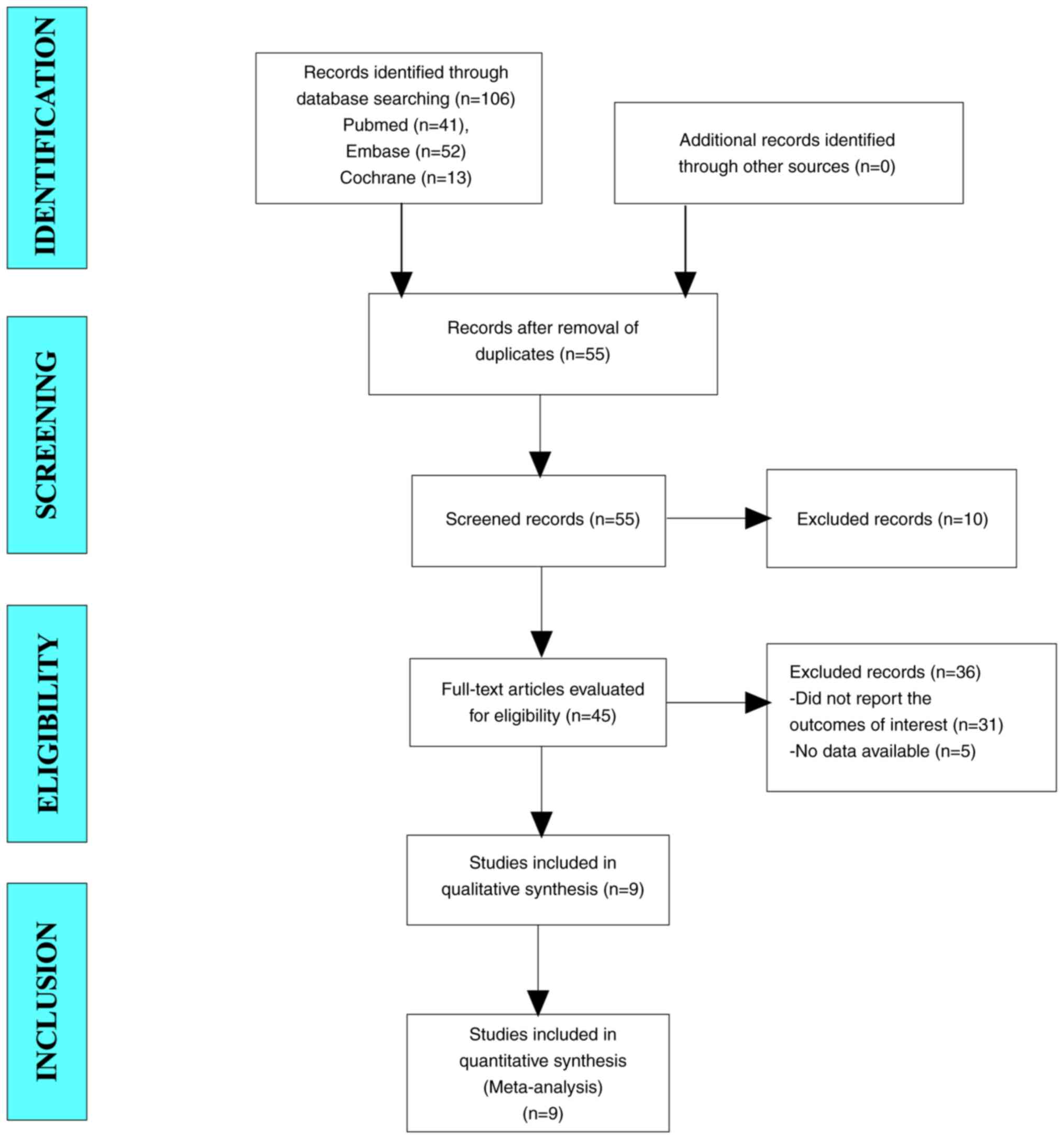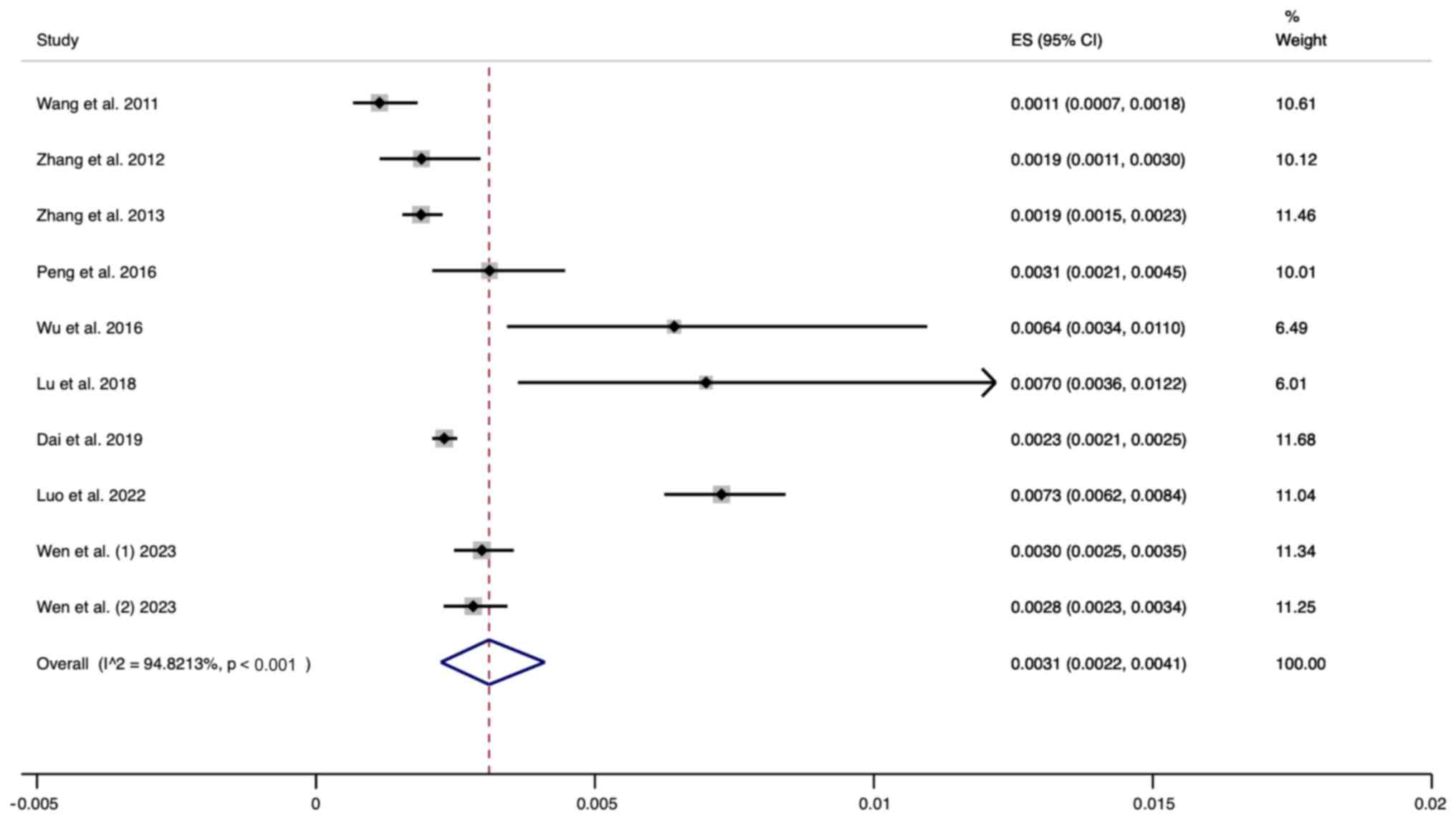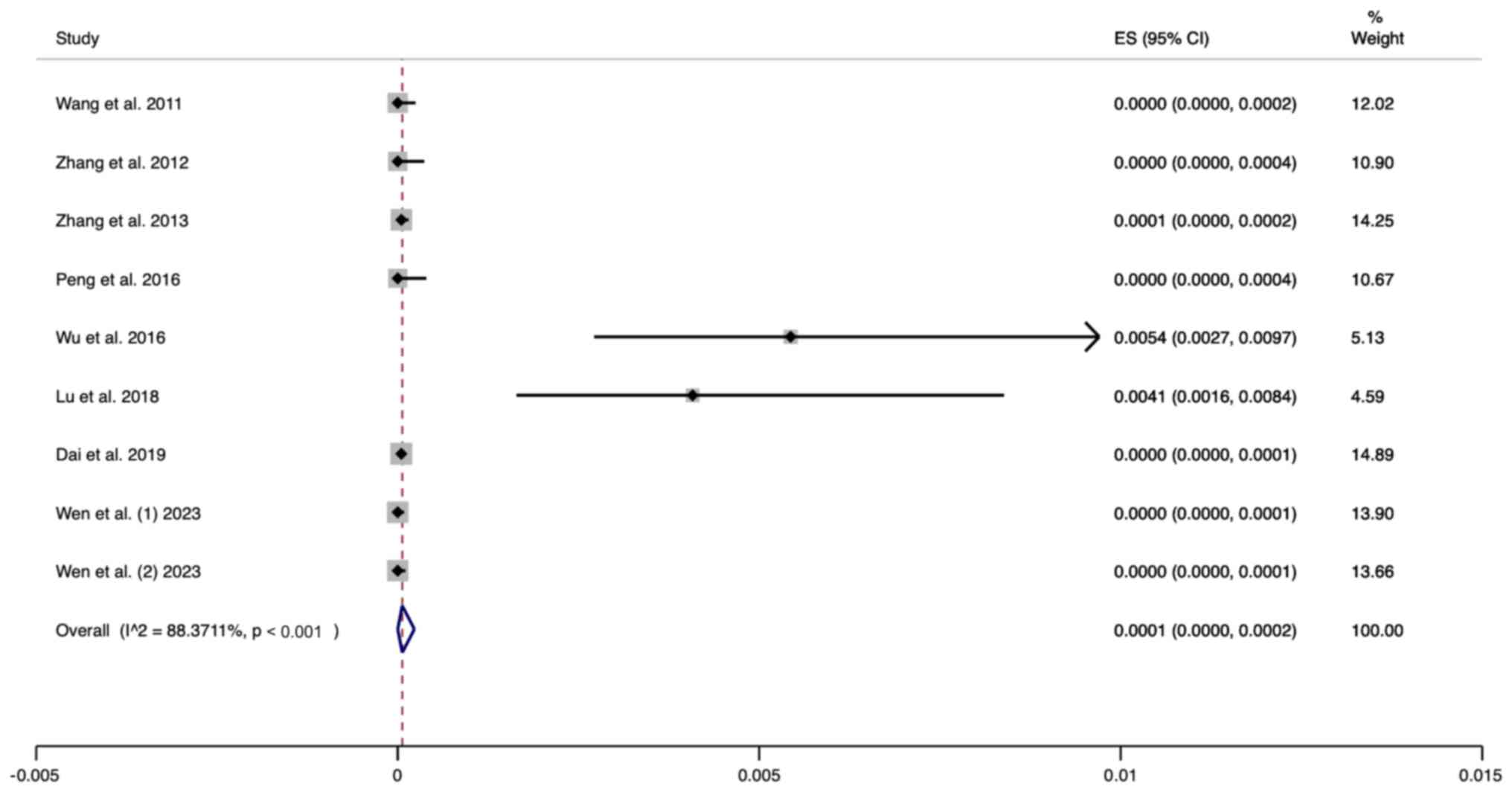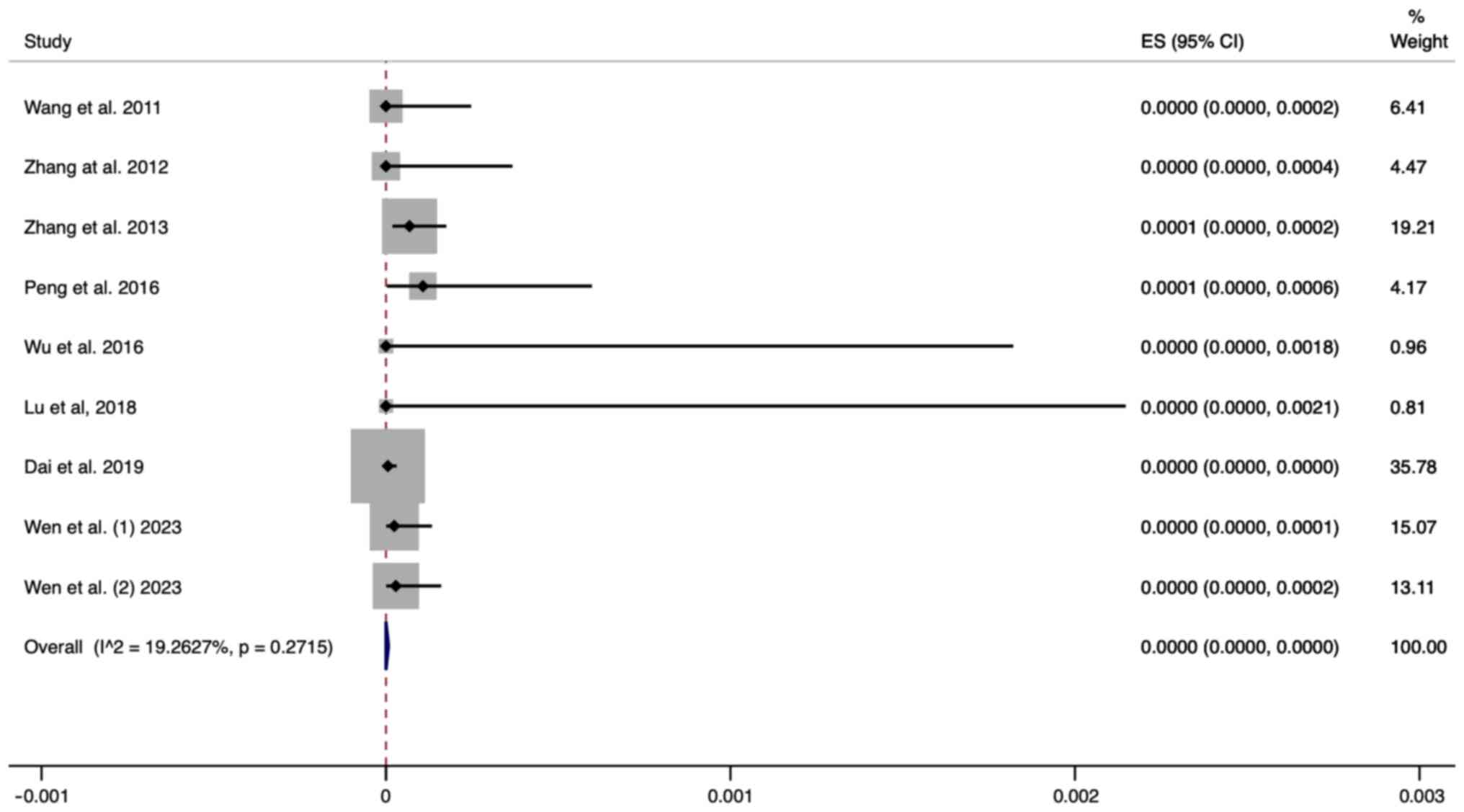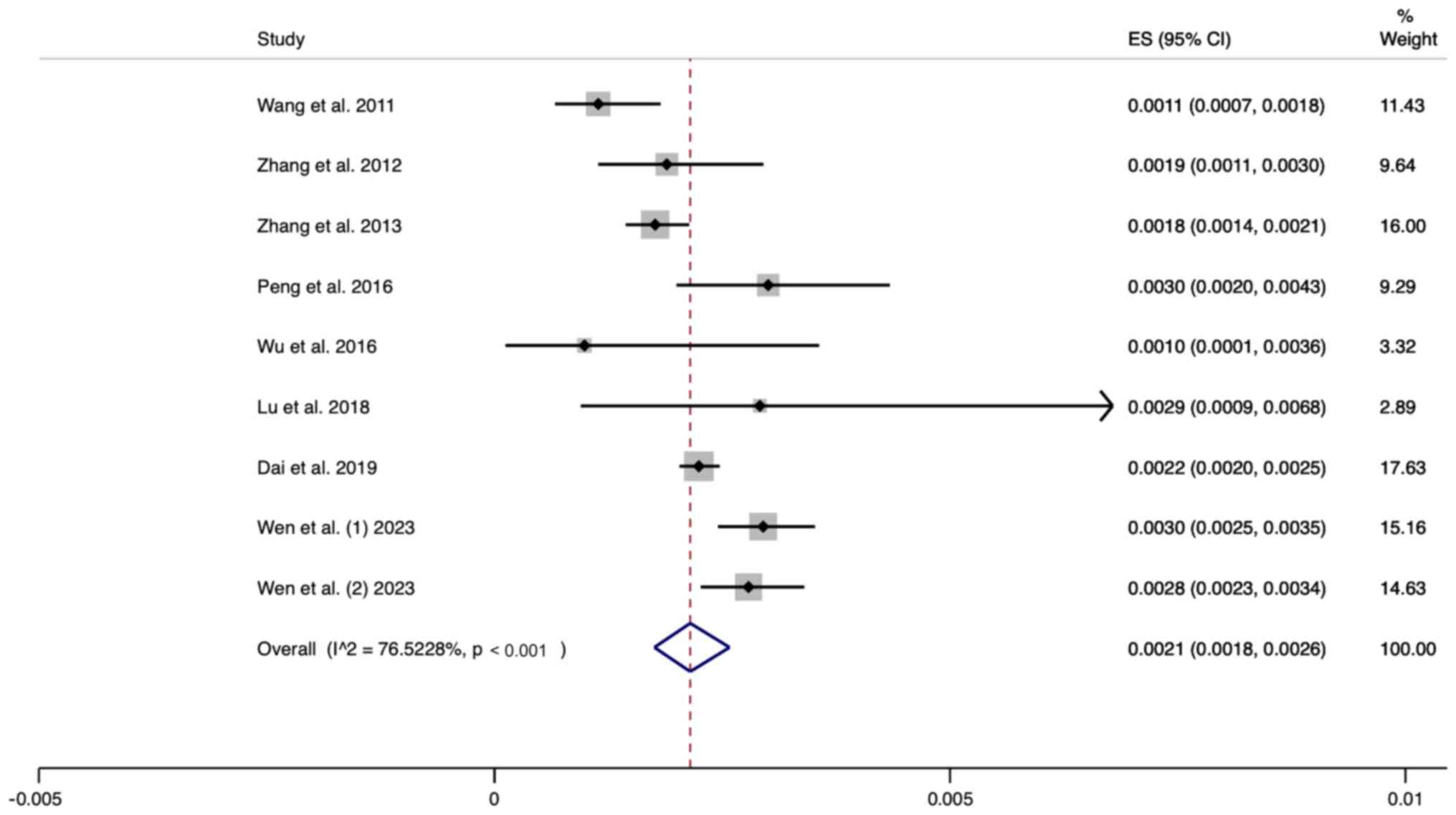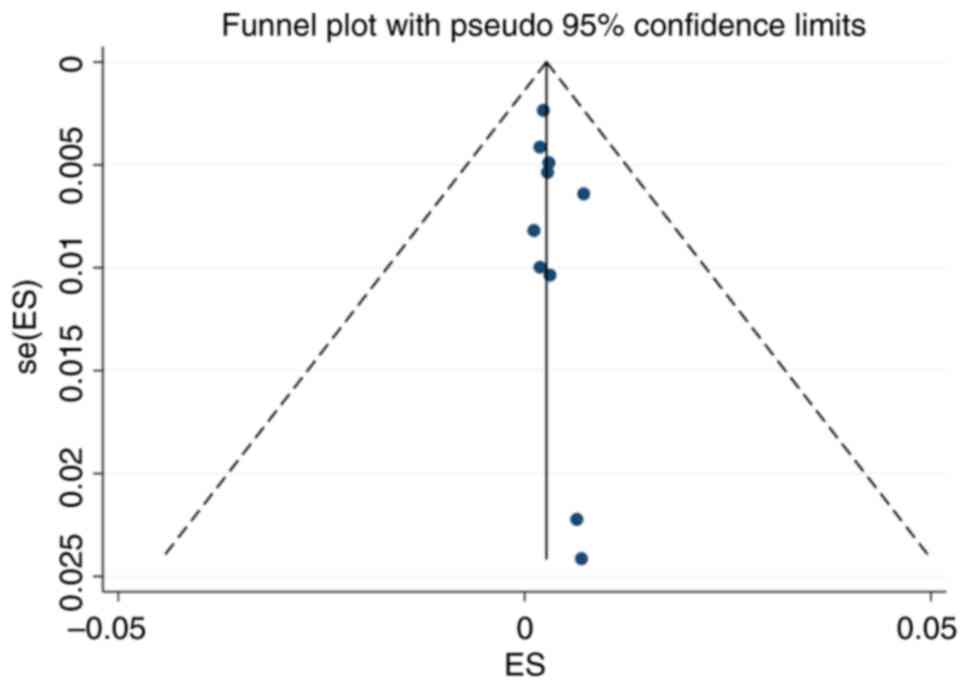Newborn concurrent hearing and genetic screening for hearing impairment: A systematic review and meta‑analysis
- Authors:
- Published online on: July 16, 2024 https://doi.org/10.3892/etm.2024.12654
- Article Number: 365
-
Copyright: © Pan et al. This is an open access article distributed under the terms of Creative Commons Attribution License.
Abstract
Introduction
Hearing loss is the most prevalent neurosensory disorder in humans. The World Health Organization stated in its World Report on Hearing that >1.5 billion individuals presently experience various levels of hearing impairment. Alarmingly, this number is projected to increase to 2.5 billion by the year 2050(1). The reported incidence of hearing loss in newborns ranges from 1 to 2 per 1,000 births, with a genetic cause identified in more than half of these cases (2,3). Early detection and intervention are crucial for hearing loss in newborns. Hearing loss is one of the most common congenital anomalies among newborns, and if it is not diagnosed and treated in a timely manner, it can severely impact the language, social and cognitive development of a child (4). Since the 1990s, the implementation of universal newborn hearing screening (UNHS) programs has played a crucial role in the early detection, diagnosis, and intervention of hearing loss, leading to significant social benefits (4,5). The UNHS program is globally acknowledged as a highly successful public health initiative. However, this program has limitations. Traditional UNHS may not identify children with late-onset or progressive sensorineural hearing loss, potentially negating the benefits of early intervention and improved outcomes (6).
In 2006, Morton and Nance (7) pioneered the integration of molecular-level genetic screening into standard newborn hearing assessments. This innovative approach entails the collection of umbilical cord blood or heel-stick blood samples from newborns shortly after birth, typically within the first 3 days, to identify both their susceptibility to deafness and common genetic factors contributing to it (7). Several studies have demonstrated that combining newborn hearing and genetic screening significantly enhances early detection rates of hearing impairments in newborns (8-10), thereby facilitating earlier personalized and targeted counseling and intervention measures.
The ‘combined screening’ approach has demonstrated clear advantages in clinical practice, but it has yet to be fully elucidated in the context of evidence-based medicine. Therefore, this systematic review and meta-analysis aimed to determine the rate of hearing screening pass and genetic screening failure (UNHS pass/genetic failure) for hearing impairment in China. Furthermore, the present study aimed to explore the benefits of combined newborn hearing and genetic screening, particularly for the early diagnosis and intervention of hearing loss patients at genetic risk. Although previous research has revealed the potential of combined screening, further exploration is required to determine how to implement this strategy most effectively to maximize its clinical benefits (11). Specifically, it remains unclear which genetic mutations should be prioritized in standard screening protocols and how to implement these screenings in resource-limited settings. Additionally, further research is needed on the specific impact of combined screening on the success rate of early interventions and how it may improve outcomes for hearing and language development in the long term. By addressing these questions, the present study seeks not only to improve the rate of early identification of newborn hearing loss but also to explore how early diagnosis and timely interventions can provide the best developmental prospects for affected children.
Materials and methods
Protocol registration
The present systematic review and meta-analysis protocol was registered at the International Platform of Registered Systematic Review and Meta-analysis Protocols (INPLASY; registration no. INPLASY202440035; https://inplasy.com/?s=INPLASY202440035), DOI:10.37766/inplasy2024.4.0035.
Literature inclusion and exclusion criteria
The inclusion criteria were as follows: i) Original research; ii) the subjects were newborns; iii) the research detection technology was a combination of neonatal hearing and genetic screening; iv) no <3 genes were screened; v) the original data were complete, and relevant data could be extracted directly or indirectly for statistical analysis; and vi) the study was published in English.
The exclusion criteria were as follows: i) Duplicate published studies; ii) incomplete data or unavailable data; iii) animal experiments; iv) case reports, reviews and systematic reviews; v) non-universal neonatal hearing and genetic screening; and vi) fewer than 3 genes were screened.
Search strategy
In the present meta-analysis, the PubMed (https://pubmed.ncbi.nlm.nih.gov/), Embase (https://www.embase.com/) and Cochrane Library databases (https://www.cochranelibrary.com/) were searched from inception to September 2023. The search terms used were ‘newborn’ ‘neonate’ AND ‘hearing loss’ ‘deaf’ AND ‘hearing screening’ AND ‘genetic screening’.
Literature screening and data extraction
Specifically, two researchers conducted the literature search, data screening and data extraction processes. Any disagreements were resolved by consulting a third party. The following data were extracted from the included studies: Basic information from the literature, the sample size of the study, the sex and weight of the study population, and the number of individuals who passed the hearing screening but failed the genetic screening, including gap junction protein beta 2 (GJB2), solute carrier family 26 member 4 (SLC26A4) and mitochondrially encoded 12S RRNA (MT-RNR1). The basic information of the document included the title of the document, the first author, and the year of publication.
Literature quality assessment
The 11-item, cross-sectional Research Quality Evaluation Scale recommended by the Agency for Health Research and Quality (AHRQ) in the United States was used to evaluate the quality of the included studies. Responses of ‘yes’, ‘no’ and ‘not clear’ were scored as ‘1’, ‘0’ and ‘0’, respectively. The total score ranges from 0 to 11 points. Scores from 0 to 3 are classified as low quality, scores from 4 to 7 are classified as medium quality, and scores from 8 to 11 are classified as high quality (12). The meta-analysis was performed in accordance with the Preferred Reporting Items for Systematic Reviews and Meta-Analyses (PRISMA) guidelines (13).
Data synthesis and statistical analysis
All the data were processed with the statistical software STATA 15.1 (StataCorp LP). For the synthesis analysis of the primary outcomes, the weighted mean effect size and its 95% confidence interval (CI) for each study were calculated to estimate the overall impact of combined screening on the detection rate of newborn hearing loss. When multiple studies reported the same outcome measures, forest plots were utilized to visually display the effect sizes and their CIs for each study, as well as the total effect size after combining all studies. A heterogeneity test result of P>0.1 and I2<50% indicated homogeneity across; P<0.1 and I2>50% indicated heterogeneity. In cases of heterogeneity, sensitivity analysis was performed to identify the sources of heterogeneity, and a random effects model was applied. This meta-analysis used a random effects model to summarize the effects. The funnel plot method and Egger's test were used to investigate publication bias (14).
Results
Literature search results
A total of 106 articles were initially retrieved from the literature search. After excluding duplicate trials, 55 trials remained for screening. After reading the titles and abstracts, a total of 45 articles were included for full-text screening. Ultimately, nine studies were included in the meta-analysis (Fig. 1).
Baseline characteristics and quality assessment of the included studies
A total of nine cross-sectional studies were included in this meta-analysis (15-23). The sample sizes ranged from 1,716 to 180,469, and there were a total of 377,688 participants. Among the studies describing the sex distribution, there were 89,701 male and 81,188 female participants, indicating that the sex distribution was even. The mean body weight ranged from 3,145.9 to 3,294.6 g (Table I). The AHRQ scores used for quality assessment were all above eight (Table II).
Results of meta-analysis. Prevalence of UNHS pass/genetic screening failure in neonates
A total of ten studies were included in this analysis. The random effects model was used for analysis. The pooled results revealed that the prevalence of passing the UNHS while failing genetic screening was 0.0031 (95% CI, 0.0022-0.0041) (Fig. 2).
Prevalence of UNHS pass/GJB2 variant screening failure in neonates
A total of nine studies were included in the present meta analysis. The random effects model was used for analysis. The pooled results revealed that the prevalence of passing the UNHS and failing the GJB2 variant screening was 0.0001 (95% CI, 0.0000-0.0002) (Fig. 3).
Prevalence of NHS pass/SLC26A4 variant screening failure in neonates
A total of nine studies were included in this analysis. The random effects model was used for analysis. The pooled results revealed that the prevalence of passing the UNHS and failing the SLC26A4 variant screening was 0.0000 (95% CI, 0.0000-0.0000) (Fig. 4).
Prevalence of NHS pass/MT-RNR1 variant screening failure in neonates
A total of nine studies were included in this analysis. The random effects model was used for analysis. The pooled results revealed that the prevalence of passing the UNHS and failing the MT-RNR1 variant screening was 0.0021 (95% CI, 0.0018-0.0026) (Fig. 5).
Sensitivity analysis
A sensitivity analysis was performed to exclude each of these trials one by one and then a pooled analysis of the remaining trials was performed. The results revealed that no individual study had a significant effect on the pooled outcomes, indicating that the results of the meta-analysis were stable and reliable.
Publication bias
The funnel plot for the included studies is basically symmetrical. The P-value of Egger's test was 0.267, indicating that no significant publication bias was found in the present study (Fig. 6).
Discussion
In 2007, Wang et al (24) initially outlined the protocol and strategy for concurrent screening of hearing and genetic factors of newborns. They recommended a combined approach for prelingual hearing loss, high-risk children with delayed-onset hearing issues, and carriers of genes associated with deafness. Additionally, they emphasized the importance of incorporating regular follow-up and monitoring. This approach has since evolved into a robust and effective screening strategy (24). The present meta-analysis included a total of nine articles and investigated 377,688 newborns. The authors calculated the rate of passing the hearing screening while failing the genetic screening and explored the advantages of combined newborn hearing and genetic screening.
The present study took the perspective of evidence-based medicine to explore the advantages of combined newborn hearing and genetic screening. The results of the meta-analysis revealed that the rate of passing the hearing screening while failing the genetic screening was 0.31%. Among these cases, the rate of passing the hearing screening while failing the mitochondrial gene screening was 0.21%, while it was 0.01% for the GJB2 gene screening, and 0.00% for the SLC26A4 gene screening. In 2019, researchers analyzed 16 studies on neonatal hearing and genetic screening and discovered that the weighted average of the failure rate of hearing screening and genetic screening was 1.4% (25), which was higher than the combined rate of 0.22% obtained from the random effects model meta-analysis in the present study. These main differences can be summarized in the following three points. i) Scope of genetic screening: The previous studies did not limit the scope of genetic screening and included a wide range of studies with varying qualities. The studies included in their research included screening strategies ranging from single-gene single-locus studies to studies involving multiple genes and 20 loci. ii) Diverse study populations: Previous studies did not have uniform requirements for study subjects, including various screening populations. Some of the studies in the literature focused only on pediatric patients with confirmed diagnoses of sensorineural hearing loss. iii) Meta-analysis methodology: Previous studies did not use a standardized meta-analysis method. They directly merged the effect rates of each independent sample, simply calculating their arithmetic averages, without considering the weight of each original study. By contrast, the present study strictly established inclusion and exclusion criteria, including data from universally conducted newborn hearing and genetic screening, rather than a specific population. A rigorous evaluation of literature heterogeneity and publication bias was also conducted, ensuring greater stability of the results. Due to the different genetic screening strategies used in different studies, the rates of hearing screening and genetic screening failure varied somewhat between these groups, ranging from 0 to 0.67% (26). Currently, a variety of genetic screening strategies have been adopted both domestically and internationally. These included single-gene single-locus screening, screening of three genes and four loci, screening of three genes with multiple loci, screening of four genes with nine loci, and screening of four genes with 20 loci, among others. To meet the statistical requirements and reduce heterogeneity, the present study included only studies in which at least three deafness-related genes were screened during the meta-analysis process. This approach enhances the credibility of the meta-analysis results and increases the clinical reference value of the present study.
The present study revealed that the rate of passing the hearing screening, while failing the genetic screening was 0.31%. This suggests that combined screening can additionally detect 0.31% of newborns carrying mutations in genes associated with hearing loss, which cannot be detected through physical screening alone. Among these patients, 0.21% passed the hearing screening, while failing the mitochondrial gene screening. This indicates that combined screening can additionally detect 0.21% of newborns carrying pathogenic variations in mitochondrial genes. This approach is equivalent to detecting 1 newborn carrying a pathogenic mitochondrial gene variation for every 500 newborns screened through the combined approach. Notably, newborns with mitochondrial gene mutations are missed by pure hearing screening, and they are at significant risk of irreversible hearing loss when exposed to aminoglycoside medications. Therefore, the application of a combined screening strategy, along with knowledge of genetic screening results and associated risks, allows for the effective avoidance of exposure to specific medications, thus preserving excellent hearing and preventing tragic outcomes such as ‘ototoxicity from a single dose’. This approach serves as a preventive measure against adverse events. Combining screening with regular follow-up and monitoring is a potent strategy for the early detection of prelingual hearing loss, identifying individuals sensitive to medications, identifying late-onset high-risk children, or identifying carriers of genes associated with deafness. It also guides appropriate intervention plans, enabling early personalized targeted interventions (27,28). Furthermore, the simplicity and cost-effectiveness of this method make it a viable option in both resource-rich and resource-limited settings, ensuring a broader implementation potential. Additionally, its non-invasive nature and rapid feedback of results enhance patient compliance and facilitate early diagnosis, which are crucial for effective intervention.
Therefore, the concurrent newborn hearing and genetic screening offer the following advantages over traditional newborn-hearing screening methods: i) Early identification of genetic hearing loss: By integrating genetic screening, it is possible to identify genetic hearing loss early on, that external hearing tests may not detect. This is because some genetic hearing losses may not manifest at birth or may appear as late-onset hearing loss. ii) Targeted intervention: Understanding the specific causes of newborn genetic hearing loss can help doctors and parents develop more personalized and targeted intervention measures, such as treatment strategies for specific gene mutations. iii) Avoiding environmental risks: For hearing loss caused by certain genetic variations, specific environmental factors (such as certain medications) may exacerbate hearing loss. Early discovery of these genetic risks through genetic screening can prevent exposure to these environmental risks, thus protecting hearing. iv) Reducing unnecessary re-screening and anxiety: Traditional hearing screening may require multiple tests to determine hearing status, especially for newborns who fail the initial screening but pass subsequent tests. Completing hearing and genetic screening all at once can reduce parental anxiety and the repetitive consumption of medical resources. v) Long-term monitoring and intervention planning: For genetic hearing loss, even if the initial screening results are normal, hearing loss may develop over time. Genetic screening results can provide a basis for long-term monitoring and timely intervention for these children.
Of note, the present study also has several limitations: i) Despite incorporating multiple studies in this meta-analysis, the small sample sizes of some studies might have impacted the reliability and generalizability of the results. Studies with small sample sizes are often more susceptible to random errors, which could lead to biased outcomes. Identifying such biases is crucial for interpreting the overall results of a meta-analysis. Therefore, a random effects model was used to pool the results of various studies, considering the heterogeneity among studies to mitigate the impact of biases that might arise from small study groups on the overall conclusions. Additionally, a sensitivity analysis was conducted by systematically excluding small-sample studies to observe their impact on the overall conclusions; however, the results of the sensitivity analysis revealed that the conclusions of this meta-analysis are robust. Future research should consider recruiting larger sample sizes to enhance the reliability of the findings and reduce the risk of bias. ii) The present study aimed to conduct a comprehensive analysis of the effectiveness of combined newborn hearing and genetic screening. However, the limitations in the data of the present study must be acknowledged and considered as a preventive reason for the authors not conducting subgroup analyses. Future research should endeavor to collect more comprehensive data, including but not limited to the gestational age at birth and different types of genetic mutations in newborns. This would enable researchers to carry out more detailed subgroup analyses, thereby enhancing the understanding of how the benefits of combined screening may vary among different populations and how screening strategies could be optimized based on the specific needs of certain subgroups. iii) The present study, focused on the initial results of newborn hearing and genetic screening rather than long-term follow-up data. Considering that the subjects were newborns, screenings are usually conducted shortly after birth, aiming to promptly identify potential hearing impairments and genetic risks. Therefore, the traditional concept of ‘follow-up rates’ does not apply to the present study; the present study concentrated on the analysis of the data at the time of screening. Among newborns with positive initial screening results, the proportion who underwent further diagnostic tests may be low. This is indeed a matter of concern, as it could affect the accuracy of the estimates of the prevalence of hearing loss or genetic mutations. In future work, ensuring comprehensive follow-up and assessment for individuals with positive initial screenings will be crucial to improving the quality of research. Additionally, due to the studies included not focusing on the types of hearing loss, this research was unable to further analyze the differences among various types of hearing loss. Future work necessitates the conduct of large-scale cross-sectional studies to delve into the variations in genetic screening results across different types of hearing loss. Such investigations will contribute to a deeper understanding of the underlying mechanisms and guide more precise intervention measures.
In summary, the results of the present study indicated that the rate of passing the hearing screening while failing the genetic screening is 0.31%. Specifically, the rate of passing the hearing screening while failing the MT-RNR1 screening was 0.21%, and for the GJB2 screening, it was 0.01%. Combined screening has a significant advantage over pure hearing screening, especially in terms of identifying newborns with mitochondrial gene mutations, which increases the sensitivity of these patients to certain medications. Given these findings, the integration of genetic screening into newborn hearing screening programs is recommended, especially for infants with a family history of genetic hearing loss. Additionally, future research should focus on evaluating the effectiveness of combined screening across diverse populations, exploring new genetic markers to enhance screening accuracy, and further investigating the long-term impact of this strategy on the hearing development and language abilities of children, and overall quality of life for them and their families. Through these efforts, the aim in the present study was to improve early diagnosis and intervention measures for newborn hearing loss, thereby improving the health and well-being of affected children.
Acknowledgements
Not applicable.
Funding
Funding: This study was supported by Mianyang City Health Commission 2019 Research Project Grant (grant no. 201910).
Availability of data and materials
The data generated in the present study may be requested from the corresponding author.
Authors' contributions
KP, ZS and JLi analyzed the data and wrote the manuscript. YW and JLu participated in the literature review and figure drawing. The genetic test for deafness was completed by JL, YW and ZS. DZ and AW participated in the data extraction and literature quality assessment. PX, DZ and AW conducted the data collection and analysis. TL and LL participated in figure drawing and data analysis. KP and PX confirm the authenticity of all the raw data. PX conceived the study. All authors read and approved the final version of the manuscript.
Ethics approval and consent to participate
Not applicable.
Patient consent for publication
Not applicable.
Competing interests
The authors declare that they have no competing interests.
References
|
Nieman CL and McMahon CM: The World Health Organization's world report on hearing: A call to action for hearing care providers. J Laryngol Otol. 134:377–378. 2020.PubMed/NCBI View Article : Google Scholar | |
|
Fortnum HM, Summerfield AQ, Marshall DH, Davis AC and Bamford JM: Prevalence of permanent childhood hearing impairment in the United Kingdom and implications for universal neonatal hearing screening: Questionnaire based ascertainment study. BMJ. 323:536–540. 2001.PubMed/NCBI View Article : Google Scholar | |
|
Kennedy C and McCann D: Universal neonatal hearing screening moving from evidence to practice. Arch Dis Child Fetal Neonatal Ed. 89:F378–F383. 2004.PubMed/NCBI View Article : Google Scholar | |
|
Tobe RG, Mori R, Huang L, Xu L, Han D and Shibuya K: Cost-effectiveness analysis of a national neonatal hearing screening program in China: Conditions for the scale-up. PLoS One. 8(e51990)2013.PubMed/NCBI View Article : Google Scholar | |
|
Huang LH, Zhang L, Tobe RY, Qi FH, Sun L, Teng Y, Ke QL, Mai F, Zhang XF, Zhang M, et al: Cost-effectiveness analysis of neonatal hearing screening program in China: Should universal screening be prioritized? BMC Health Serv Res. 12(97)2012.PubMed/NCBI View Article : Google Scholar | |
|
Young NM, Reilly BK and Burke L: Limitations of universal newborn hearing screening in early identification of pediatric cochlear implant candidates. Arch Otolaryngol Head Neck Surg. 137:230–234. 2011.PubMed/NCBI View Article : Google Scholar | |
|
Morton CC and Nance WE: Newborn hearing screening-a silent revolution. N Engl J Med. 354:2151–2164. 2006.PubMed/NCBI View Article : Google Scholar | |
|
Wang Q, Xiang J, Sun J, Yang Y, Guan J, Wang D, Song C, Guo L, Wang H, Chen Y, et al: Nationwide population genetic screening improves outcomes of newborn screening for hearing loss in China. Genet Med. 21:2231–2238. 2019.PubMed/NCBI View Article : Google Scholar | |
|
Tang X, Liu L, Liang S, Liang M, Liao T, Luo S, Yan T and Chen J: Concurrent newborn hearing and genetic screening in a Multi-ethnic population in South China. Front Pediatr. 9(734300)2021.PubMed/NCBI View Article : Google Scholar | |
|
Barendregt JJ, Doi SA, Lee YY, Norman RE and Vos T: Meta-analysis of prevalence. J Epidemiol Community Health. 67:974–978. 2013.PubMed/NCBI View Article : Google Scholar | |
|
Yáñez-Baeza C, Aguilera-Eguía RA, Fuentes-Barría H and Roco-Videla Á: Importance of the PRISMA guideline. Nutr Hosp. 40:670–675. 2023.PubMed/NCBI View Article : Google Scholar : (In Spanish). | |
|
Zhu QW, Li MT, Zhuang X, Chen K, Xu WQ, Jiang YH and Qin G: Assessment of hearing screening combined with limited and expanded genetic screening for newborns in Nantong, China. JAMA Netw Open. 4(e2125544)2021.PubMed/NCBI View Article : Google Scholar | |
|
Zeng X, Liu Z, Wang J and Zeng X: Combined hearing screening and genetic screening of deafness among Hakka newborns in China. Int J Pediatr Otorhinolaryngol. 136(110120)2020.PubMed/NCBI View Article : Google Scholar | |
|
Egger M, Davey Smith G, Schneider M and Minder C: Bias in meta-analysis detected by a simple, graphical test. BMJ. 315:629–634. 1997.PubMed/NCBI View Article : Google Scholar | |
|
Wang QJ, Zhao YL, Rao SQ, Guo YF, He Y, Lan L, Yang WY, Zheng QY, Ruben RJ, Han DY and Shen Y: Newborn hearing concurrent gene screening can improve care for hearing loss: A study on 14,913 Chinese newborns. Int J Pediatr Otorhinolaryngol. 75:535–542. 2011.PubMed/NCBI View Article : Google Scholar | |
|
Zhang Z, Ding W, Liu X, Xu B, Du W, Nan S and Guo Y: Auditory screening concurrent deafness predisposing genes screening in 10,043 neonates in Gansu province, China. Int J Pediatr Otorhinolaryngol. 76:984–988. 2012.PubMed/NCBI View Article : Google Scholar | |
|
Zhang J, Wang P, Han B, Ding Y, Pan L, Zou J, Liu H, Pang X, Liu E, Wang H, et al: Newborn hearing concurrent genetic screening for hearing impairment-a clinical practice in 58,397 neonates in Tianjin, China. Int J Pediatr Otorhinolaryngol. 77:1929–1935. 2013.PubMed/NCBI View Article : Google Scholar | |
|
Peng Q, Huang S, Liang Y, Ma K, Li S, Yang L, Li W, Ma Q, Liu Q, Zhong B and Lu X: Concurrent genetic and standard screening for hearing impairment in 9317 Southern Chinese Newborns. Genet Test Mol Biomarkers. 20:603–608. 2016.PubMed/NCBI View Article : Google Scholar | |
|
Wu CC, Tsai CH, Hung CC, Lin YH, Lin YH, Huang FL, Tsao PN, Su YN, Lee YL, Hsieh WS and Hsu CJ: Newborn genetic screening for hearing impairment: A population-based longitudinal study. Genet Med. 19:6–12. 2017.PubMed/NCBI View Article : Google Scholar | |
|
Lu CY, Tsao PN, Ke YY, Lin YH, Lin YH, Hung CC, Su YN, Hsu WC, Hsieh WS, Huang LM, et al: Concurrent hearing, genetic, and cytomegalovirus screening in Newborns, Taiwan. J Pediatr. 199:144–50.e1. 2018.PubMed/NCBI View Article : Google Scholar | |
|
Dai P, Huang LH, Wang GJ, Gao X, Qu CY, Chen XW, Ma FR, Zhang J, Xing WL, Xi SY, et al: Concurrent hearing and genetic screening of 180,469 neonates with Follow-up in Beijing, China. Am J Hum Genet. 105:803–812. 2019.PubMed/NCBI View Article : Google Scholar | |
|
Luo H, Yang Y, Wang X, Xu F, Huang C, Liu D, Zhang L, Huang T, Ma P, Lu Q, et al: Concurrent newborn hearing and genetic screening of common hearing loss variants with bloodspot-based targeted next generation sequencing in Jiangxi province. Front Pediatr. 10(1020519)2022.PubMed/NCBI View Article : Google Scholar | |
|
Wen C, Yang X, Cheng X, Zhang W, Li Y, Wang J, Wang C, Ruan Y, Zhao L, Lu H, et al: Optimized concurrent hearing and genetic screening in Beijing, China: A cross-sectional study. Biosci Trends. 17:148–159. 2023.PubMed/NCBI View Article : Google Scholar | |
|
Wang QJ, Zhao YL, Lan L, Zhao C, Han MK and Han DY: Studies of the strategy for newborn gene screening. Zhonghua Er Bi Yan Hou Tou Jing Wai Ke Za Zhi. 42:809–813. 2007.PubMed/NCBI(In Chinese). | |
|
D'Aguillo C, Bressler S, Yan D, Mittal R, Fifer R, Blanton SH and Liu X: Genetic screening as an adjunct to universal newborn hearing screening: Literature review and implications for non-congenital pre-lingual hearing loss. Int J Audiol. 58:834–850. 2019.PubMed/NCBI View Article : Google Scholar | |
|
Nivoloni Kde A, da Silva-Costa SM, Pomilio MC, Pereira T, Lopes Kde C, de Moraes VC, Alexandrino F, de Oliveira CA and Sartorato EL: Newborn hearing screening and genetic testing in 8974 Brazilian neonates. Int J Pediatr Otorhinolaryngol. 74:926–929. 2010.PubMed/NCBI View Article : Google Scholar | |
|
Han B, Zong L, Li Q, Zhang Z, Wang D, Lan L, Zhang J, Zhao Y and Wang Q: Newborn genetic screening for high risk deafness-associated mutations with a new Tetra-primer ARMS PCR kit. Int J Pediatr Otorhinolaryngol. 77:1440–1445. 2013.PubMed/NCBI View Article : Google Scholar | |
|
Guo L, Xiang J, Sun L, Yan X, Yang J, Wu H, Guo K, Peng J, Xie X, Yin Y, et al: Concurrent hearing and genetic screening in a general newborn population. Hum Genet. 139:521–530. 2020.PubMed/NCBI View Article : Google Scholar |



